Maxim-Silverman self-loading pistol (UK)
Successful small arms projects were implemented by H.S. Maxim with the direct assistance of several colleagues. One of the first employees of his arms firm was Louis Silverman. In the future, this specialist most actively helped the work manager and made a significant contribution to the improvement of finished structures and the creation of new projects. In the mid-nineties of the 19th century, X. Maxim and L. Silvermen proposed several original designs of self-loading weapons, now known under the common name by the names of designers.
At the end of 1896, the designers applied for a British patent. In the autumn of the next 1897, the patent office confirmed their priority and issued the document number 29836. The patent provided a description of two versions of the design of self-loading pistols. This weapon used unitary pistol cartridges and was equipped with its own store. In addition, both projects included the use of automation, providing self-recharge after each shot.
In the same period, the workshop of H.S. Maxima made several prototypes of one of two pistols. This weapon was intended for testing at a shooting range and testing proposed ideas. Upon receipt of positive results, the project could be developed and even reach mass production.
The project proposed the manufacture of a self-loading pistol with automation based on a free gate. The weapon was supposed to use an 7,65x25 mm Borchardt cartridge. Some sources indicate the use of other cartridges of similar caliber, but the remaining copies of the Maxim-Silverman pistol have barrels of 7,65 mm caliber. According to the authors, the new pistol should have been distinguished by its great simplicity of design and original appearance. Recognition of the exterior gave a thin profile of the trunk and frame, from which the inclined handle departed at a large angle.
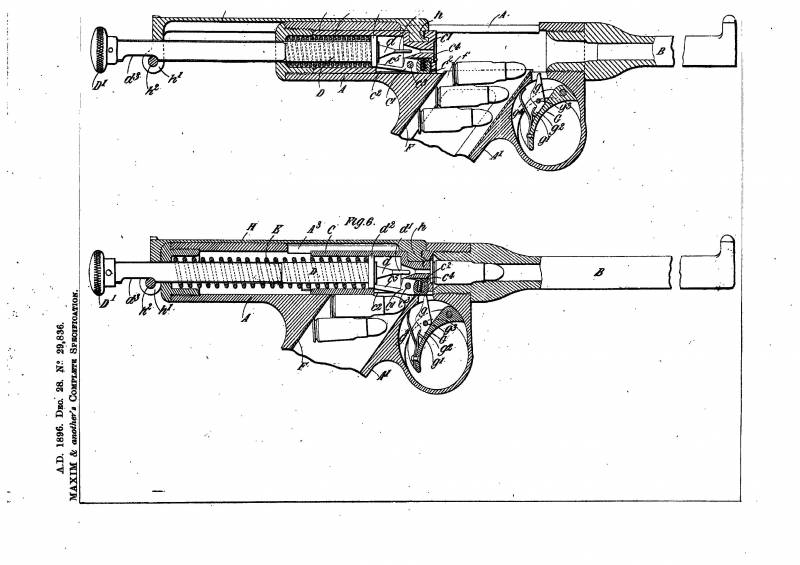
The work of automation: at the top - the bolt in the rearmost position, at the bottom - the weapon in the cocked state. Patent drawing
The pistol had to be distinguished by simplicity, which could be traced both in the general layout and in the design of the automatics. About half the length of the pistol held a rifled barrel. The barrel connected to the frame, made in the form of a tube with a handle welded to it. On the upper surface of the tubular structural member there was a sliding longitudinal cover. In the back of the cork frame there was a slot for withdrawal of thrust with the shutter control handle.
An aggregate was attached to the tubular element of the frame, combining the handle and the trigger guard. This device was made of metal. Inside it were some necessary structural elements. So, inside the handle there was a cavity for installing a magazine, and in front of it, under the bracket, there was a trigger.
The Maxim-Silverman pistol received a relatively long rifled barrel with a caliber 7,65 mm. One of the surviving specimens was equipped with a round barrel. The other, in turn, is distinguished by the octagonal shape of the outer surface of the trunk. In this case, both barrels were equipped with an influx of fly near the barrel. At the breech provided for thickening to install the barrel in the frame. Inside this bulge was a chamber. The rear section of the trunk was at a certain depth in the tubular frame.
Inside the tubular casing of the frame were placed the basic elements of automation, namely, the bolt with a drummer and a reciprocating combat spring. In front of the frame, near the rear section of the chamber, a part of the details of a simple trigger was placed. It was the simplification of the USM that made it possible to reduce the size of the frame and minimize the cross section of the tubular casing. At the top of the tube there was a hole for ejection of spent cartridges. In the forward position of the shutter, this opening was closed by a special movable lid, which was an element of automation.
The pistol bolt was a hollow tubular part with a thickened front wall, in the center of which there was a hole for the output of the drummer. At the top and bottom of this thickening were provided grooves for additional devices. So, on top of the shutter joined the outer cover, located outside the casing. Below it was placed a small lever, which was responsible for keeping the drummer in front of the shot.
In the cavity of the gate was placed drummer of complex shape, equipped with a long shank. The front part of the drummer had a needle head mounted on a transverse disk. Behind the disc was a long shank of rectangular cross section. The latter passed through the entire length of the frame and went beyond its limits through the hole in the back cover. There it was placed round the handle, with which it was proposed to carry out the cocking of weapons. There was a groove in front of the handle to secure the back of the outer cover. The entire space between the drummer's disk and the back cover of the frame was occupied by the reciprocating spring.
H.S. Maxim and L. Silvermen proposed an original trigger type of a shock type, the details of which were located on the frame and on the gate. Directly under the chamber, inside the guard, a spring-loaded trigger was placed. Inside it there was a groove in which a simple form pusher was placed. The latter through the hole in the tubular casing could interact with the details of the bolt.
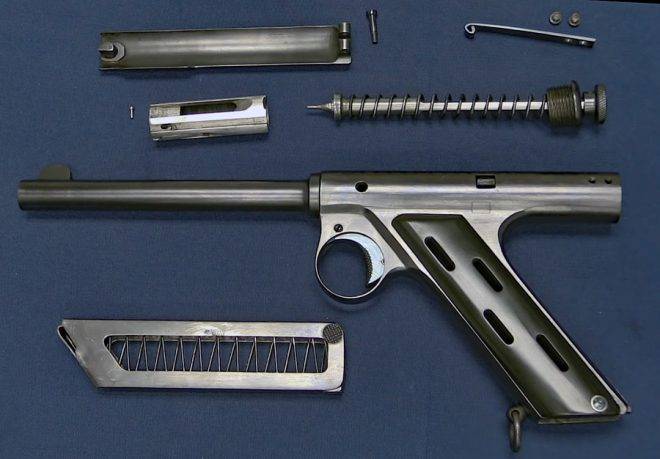
Incomplete disassembly of the gun. Photo Alloutdoor.com
The front part of the bolt had a groove in which the swing arm was placed with a long rear shoulder. When the USM is cocked, this lever arm propped up the drummer and did not allow him to move forward, initiating a shot. The trigger pusher pressed on the second shoulder and thereby released the drummer. The gun had no means of blocking the trigger. When using prototypes, testers should be especially careful.
The Maxim-Silverman pistol was supposed to use detachable box magazines on 8 cartridges. The store had a specific shape that repeated the main contours of the handle. With the help of a spring-loaded feeder mounted on the bottom, the cartridges were lifted one by one inside the tubular assembly, where they had to be picked up by the bolt. In its place, the store was held by the latch of a simple design.
Experienced pistols of the new type were equipped with the simplest sights. On the trunk, near its muzzle, there was an influx that served as a fly. On the rear section of the upper movable cover there was a low rear sight. Naturally, such a sight could not be adjusted in range or under a side wind.
The large slope of the handle relative to the trunk line determined the specific ergonomics of the weapon. At the same time, a certain convenience of operation was provided due to the correct shape of the side walls of the handle. The front and rear edges of the handle were straight and served as guides for the store. Between them there was a plane curved outward. Interestingly, the right “lining” of the handle had perforations in the form of several longitudinal holes.
In 1896-97, the company Hiram Maxima manufactured the first prototype of a promising weapon, with the help of which it was planned to test the main design ideas and determine the efficiency of the design. Subsequently, several more prototypes appeared. According to various sources, at least three experienced pistols could have been fired. This is the number of prototypes now kept in museums and private collections. Reliable information about the assembly of other prototypes are missing.
The second and subsequent Maxim-Silverman pistols had noticeable differences from the first prototype. This directly indicates that the basic design is far from fully complying with the requirements and could not fully solve the tasks.
According to available data, during the tests of the first prototype, it was found that the 7,65x25 mm “Borchardt” cartridge has excess power and does not correspond to the design features of the gun. As a consequence, the free gate circuit could not show the desired characteristics. The solution to this problem should have been the means of braking the shutter when it is shifted back after the shot. To turn the free gate into a semi-free one, on the left side of the tubular frame, a square window was made and a pair of holes were drilled. A small flat spring was attached to the rear holes with a pair of screws. Its front end was bent by a ring, and the latter entered the weapon through a side window.
The principle of operation of the modified semi-free pistol gun looked as follows. By placing the magazine in the handle, the shooter had to cock the weapon. This was carried out using the rear handle, placed on the shank of the drummer. When it was moved backwards, the shank interacted with the outer lid and forced the shutter to move backward. At the same time, the drummer also shifted. With the rearmost position of the shutter, the pusher of the magazine could lead the cartridge to the disilline line. Continuing to pull the shank, the shooter additionally squeezed the return-spring and displaced the drummer back, as a result of which the trigger lever blocked it in this position. With the release of the rear handle, the bolt went forward with the help of a spring, sending the cartridge and clinging to the breech barrel.
Pressing the trigger shifted its pusher, which, in turn, worked on the shutter lever. He released the drummer, after which a shot occurred. Under the effect of recoil, the shutter began to move back and removed the sleeve. Moving back, the bolt with its tail end rested against the front ring of the outer spring. The interaction with the side spring and the diversion of its ring to the side took away from the shutter a part of the received pulse. Passing by the ring, the bolt allowed a new cartridge to rise, and also provided a cocking drummer. Further, the return spring moved all the parts to their original position, and a new shot could be made.
According to reports, the company H. Maxim produced only a few experienced pistols of the original design - at least three units. The first of them was based on the basic project and used the principles of a free gate. Other pistols, according to the test results of the first, were equipped with semi-free-shutter automatics, although they had a similar design. All samples appear to have passed the necessary tests and showed the real possibilities of the original scheme. Accurate test results, unfortunately, are impossible, but subsequent events may hint at the lack of the desired results.
As far as is known, the Maxim-Silverman self-loading pistol remained at the testing stage of a set of prototypes. For one reason or another, H.S. Maxim and L. Silverman did not continue to develop the project. They focused on the development of a new machine gun design. This weapon has already been mass-produced and has had great success in the international market. It can be assumed that if there is one successful project in the field of small arms, Kh.S. Maxima no longer needed new samples to enter the market. However, it is impossible to exclude other reasons for the refusal of the gun. He could have serious problems hindering the further development of the project and reducing its real commercial prospects.
The Maxim-Silverman project offered one of the world's first self-loading pistol designs. The problem of reloading after each shot had to be solved with the help of a free / semi-free shutter and trigger mechanism of an interesting design. The undoubted advantage of such a gun - if we take into account the time of its creation - was the fact of its existence and the ability to make several shots without reloading manually. At the same time, the existing cartridge made it possible to obtain sufficiently high characteristics and use weapons in various fields. The most noticeable disadvantage of the project was the absence of any fuse. In addition, the pistol ergonomics could be considered ambiguous.
Anyway, the gun Maxim-Silverman did not go into the series. Three prototypes of such weapons have survived to this day. Now they are stored in museums and private collections. Due to the small amount of these products are of special collection value. The interest of potential buyers leads to the formation of appropriate prices. So, in October 2013, one of the experienced pistols was put up for auction with a starting price of 10 thousand US dollars. Its final cost reached 22,5 thousands. According to various sources, two of the three pistols are currently owned by private collectors, the third is in the museum.
Working on new designs of small arms, Maxim Maxim Stephens and his colleagues offered several options for automation and associated mechanisms. One of these proposals was implemented in the project gun 1896 year. This project has not advanced further test prototypes and actually did not give real results. Nevertheless, like any other early version of autoloading weapons created at the end of the 19th century, it is of great interest and occupies a special place in stories.
On the materials of the sites:
http://forgottenweapons.com/
http://alloutdoor.com/
http://icollector.com/
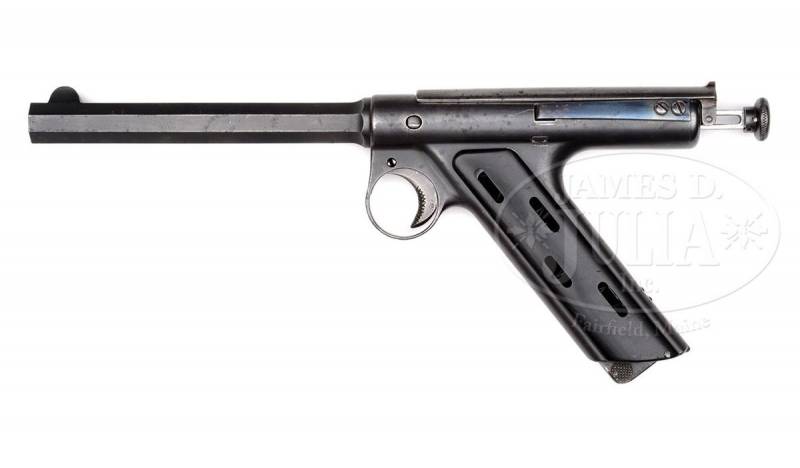
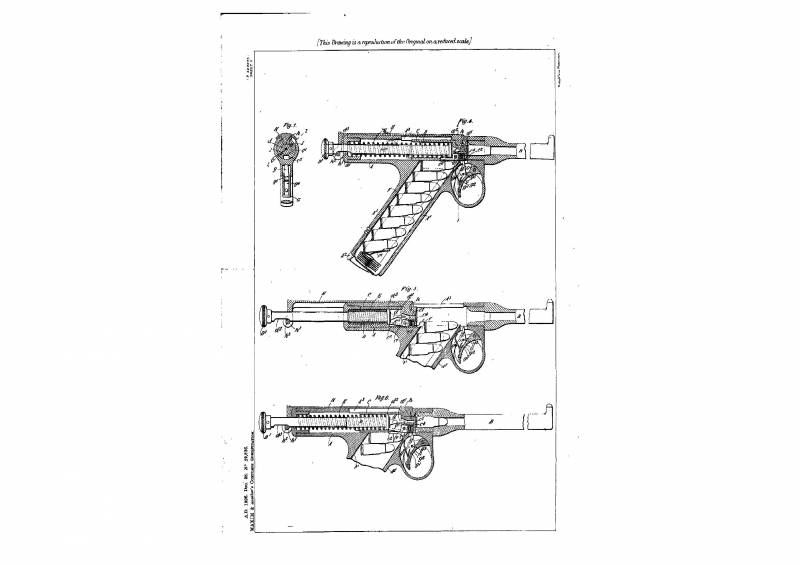
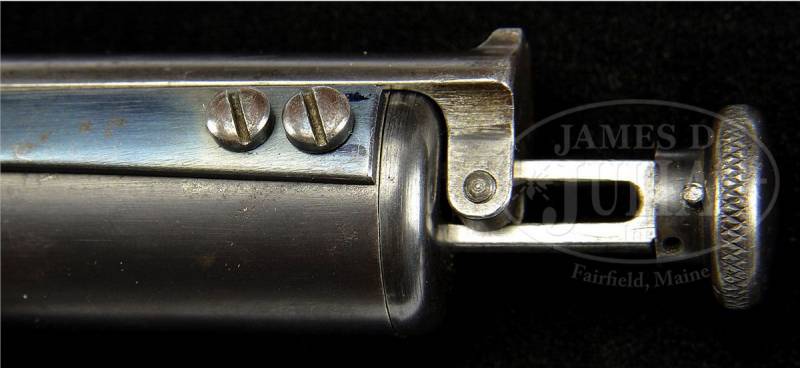
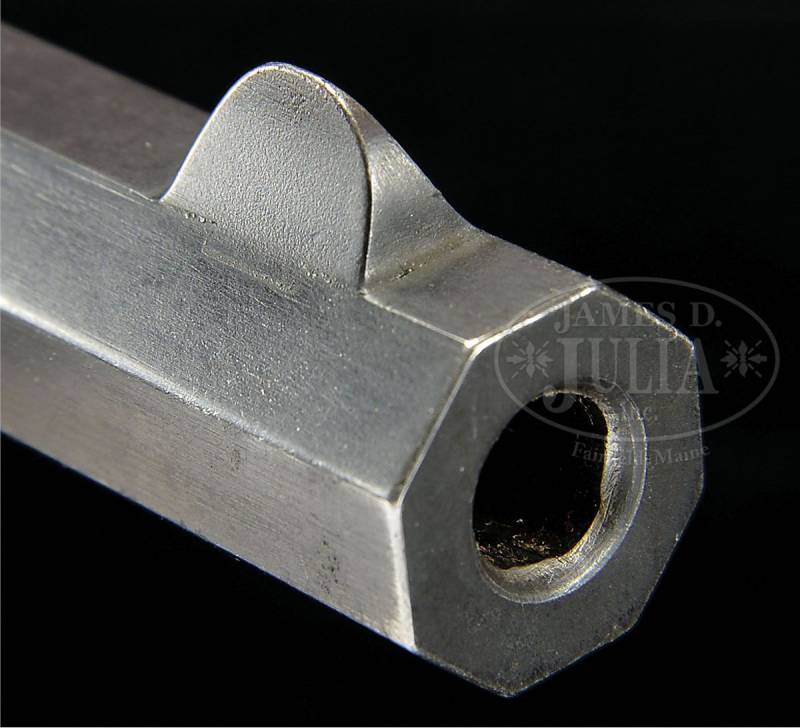
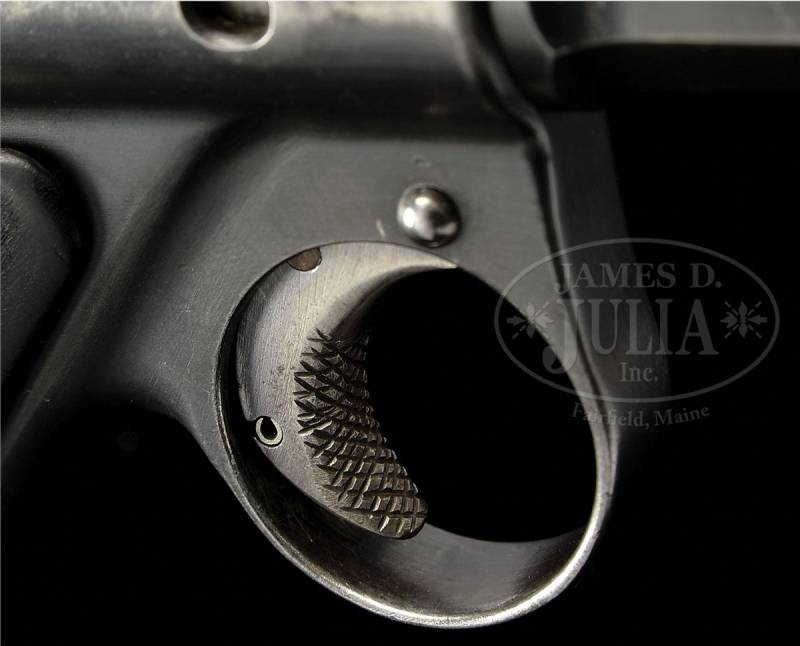
Information